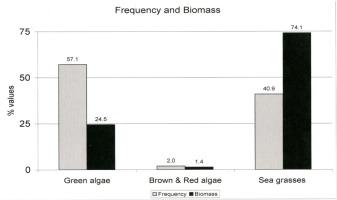Aquatic Botany ( IF 1.9 ) Pub Date : 2021-01-31 , DOI: 10.1016/j.aquabot.2021.103355 René J. Buesa

|
This study presents for the first time a comprehensive review of the macrophytobenthos on the Northwestern Cuban shelf using data collected almost 50 years ago, and can be considered as a baseline for present and future studies. During 1972−1973 the total estimated fresh biomass was 1.88 million tons (686 tons km−2). Compared with seagrasses, seaweeds were 1.40 times more frequent but had a total biomass 2.86 times smaller. Frequency wise, 90 % of all seaweeds were Chlorophyta, while Phaeophyta, and Rhodophyta were 5 % each. Six Bryopsidales genera (Avrainvillea, Caulerpa, Halimeda, Penicillus, Rhipocephalus, and Udotea) comprised 73 % of 16 Chlorophyta species collected, and 80 % of their total fresh biomass. Turtle grass (Thalassia testudinum) leaves fresh weight was 96 % of all seagrasses biomass, and 71 % of the total macrophytobenthos biomass. The combined biomass of five Halimeda species and that of turtle grass leaves were 88 % of the total regional macrophytobenthos fresh biomass. Species presence was greatest on sand substrate, and least on reef rubble, with a total biomass greater at 1 m depth on organic mud mixed with sand. Of all species, only Halimeda spp. showed seasonal changes in biomass. The total biomass of macrophytobenthos was higher in the western larger and deeper Gulf of Guanahacabibes than in the eastern smaller and shallower Buenavista cays to La Mulata Port section of the shelf. The total macrophytobenthos biomass and that of some species showed significant correlations with depth. The eight most frequent macrophytes in the Northwestern Cuba shelf had similar Caribbean presence.
中文翻译:

古巴西北部大陆架近50年前的大型底栖动物生物量
这项研究首次使用近50年前收集的数据,对古巴西北大陆架上的大型植物底栖动物进行了全面综述,可以作为当前和未来研究的基准。在1972-1973年期间,估计的新鲜生物质总量为188万吨(686吨km -2)。与海草相比,海藻的发生频率高1.40倍,但总生物量却少2.86倍。从频率上看,所有藻类中有90%为藻类,而藻类和红藻分别为5%。六个Bryopsidales属(Avrainvillea,Caulerpa,Halimeda,Penicillus,Rhipocephalus和Udotea)占收集的16种绿藻的73%,占其新鲜生物量的80%。龟草(Tha草))鲜重为所有海草生物量的96%,占总大型植物底栖生物量的71%。五个Halimeda物种和turtle草叶片的总生物量占区域大型植物底栖生物总生物量的88%。物种的存在在砂质基质上最大,而在礁石碎石上最少,在混合有砂质的有机泥中,总生物量在1 m深度处更大。在所有物种中,只有Halimedaspp。表现出生物量的季节性变化。在瓜纳卡比贝斯西部较大和较深海湾中,大型植物底栖动物的总生物量比该架子的拉穆拉塔港段的东部较小和较浅的布埃纳维斯塔礁高。大型底栖动物的总生物量和某些物种的总生物量与深度呈显着相关。古巴西北部陆架上最常见的八种大型植物具有相似的加勒比海存在。











































 京公网安备 11010802027423号
京公网安备 11010802027423号